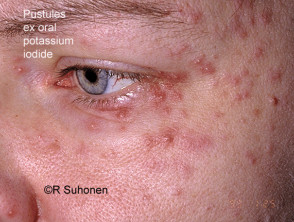What is potassium iodide?
Potassium iodide (KI) is prepared by reacting iodine with a hot solution of potassium hydroxide. It is mainly used in the form of a saturated solution, 100 g of potassium iodide to 100 ml of water. This equates to approximately 50 mg/drop. The solution is usually added to water, fruit juice or milk before drinking.
Potassium iodide has been primarily used in the treatment and prevention of simple goitre, which is endemic in areas where the diet is deficient in iodides. Goitre results from low levels of thyroid hormone. Potassium iodide is usually given for this purpose as iodised salt. Other indications include treatment of hyperthyroidism, radiation protectant of the thyroid gland, pre-operative preparation of patients with Graves disease and the treatment of some dermatological conditions such as cutaneous lymphatic sporotrichosis and inflammatory dermatoses.
How does potassium iodide help dermatological diseases?
It is not clear how potassium iodide works in the treatment of dermatological conditions but it may be because of its effect on neutrophils. Neutrophils are a type of white blood cell, important in the immune system's fight against bacteria.
Potassium iodide appears to be particularly effective in conditions where neutrophils predominate in the early stages of the disease. Its activity against fungi is possibly because it kills the fungi directly or by enhancement of the body's immunological and non-immunological defence mechanisms.
The effectiveness of potassium iodide in the treatment of dermatological diseases has been shown in a number of studies.
| Disease | Dosage | Notes |
|---|---|---|
| Sporotrichosis | Adult: 500–1500 mg daily, increasing to 4000–6000 mg daily for 6–10 weeks. Child: one half to one-third of the adult dose |
|
| Erythema nodosum Sweet disease Behcet disease Nodular vasculitis Erythema multiforme |
300–900 mg daily |
|
| Recalcitrant pyoderma gangrenosum | 300 mg 3 times daily |
|
| Granulomatosis with polyangiitis | 800 mg daily |
|
For many diseases, newer more modern treatments are now available. However, because of its effectiveness and low cost, potassium iodide is still sometimes the drug of choice. If not, it is often used as a second line drug when other treatments are found to be ineffective.
Precautions when using potassium iodide
Before using potassium iodide the following should be considered.
Medical history – inform your doctor if you have any other medical problems, especially:
- Thyroid disease
- Kidney disease
- Tuberculosis
- Hyperkalaemia (high blood levels of potassium)
Medication history – inform your doctor if you are taking any of the following medicines:
- Potassium-sparing diuretics (amiloride, spironolactone, triamterene)
- Antithyroid agents
- Lithium
Pregnancy — taking potassium during pregnancy may cause thyroid problems or goitre in the newborn infant.
Breastfeeding — potassium iodide crosses into breast milk and may cause skin rash and thyroid problems in nursing babies.
What are the side effects of potassium iodide?
Side effects are rare when potassium iodide is used in short courses and at low doses. The most common side effects are abdominal pain, diarrhoea, nausea or vomiting. These acute side effects often go away during treatment as your body adjusts to the medicine or can be lessened by avoiding rapid dosage increases. Other, less common side effects include urticaria and angioedema, which can affect the arms, face, legs, lips, tongue, throat and lymph glands.
Pustules due to potassium iodide
With prolonged use, patients may experience symptoms of iodism or potassium toxicity.
Symptoms of iodism include:
- Burning of mouth or throat
- Metallic taste
- Increased watering of mouth
- Sore teeth and gums
- Severe headache
Symptoms of potassium toxicity include:
- Confusion
- Irregular heartbeat
- Numbness, tingling, pain or weakness in hands or feet
